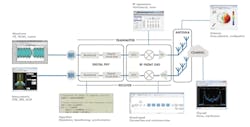The inception of 5G New Radio and emerging design challenges
The rise of 5G New Radio (NR) is ushering in exciting developments for wireless
technologies including higher data rates, lower latency, and more power-efficient implementations, according to Ken Karnofsky, senior strategist for signal-processing applications at MathWorks. As engineers rush to develop products that can deliver these features, they will discover a new set of technical challenges and complexities, he adds.
In our June Special Report on 5G,1 Karnofsky addressed software’s role in 5G development. In the following Q&A, he emphasizes that we can better understand 5G architectures and standards by realizing how they differ from those associated with 4G LTE systems.
RN: Five years ago, wireless LTE capabilities seemed more like a vision than a reality. Now, design engineers are accelerating past LTE and actively looking for ways to engage with the emerging 5G standard. How will this major transition in broadband speeds be enabled?
KK: The transition from LTE to 5G systems will be enabled by greater bandwidth and more efficient use of spectrum using massive MIMO communication in the millimeter-wave (mmWave) frequency range and flexible New Radio algorithms. Every aspect of 5G NR design, from antennas to RF electronics, will be affected by these changes. However, design engineers must be mindful that 5G subsystems are tightly coupled. To expedite the transition from LTE to 5G, and ultimately maximize performance, subsystems must be designed and evaluated together.
When you say subsystems here, I assume you’re referring to the tightly coupled 5G subsystems that must be designed and evaluated together. Are there also issues surrounding the coexistence of LTE and 5G subsystems?
Yes, that’s right. And yes, there are LTE-5G coexistence issues. For example, 5G transmissions in the sub-6-GHz portion of the spectrum must coexist with LTE as well as
Wi-Fi and legacy standards in that frequency range. While filtering techniques can help address this by attenuating the emissions outside the desired frequency range, the
coexistence requirement increases testing complexity. Simulation can be an effective method of front-loading testing and expanding the range of scenarios that can be tested.
Coexistence is also an issue for small-cell base-station deployment, as interference from base stations operating in the same or adjacent bands can reduce channel capacity. Simulated measurements together with visualization of SINR on street maps can provide early prediction of the impact on link and network performance.
Massive MIMO communication is not a foreign concept. In fact, many design engineers have an integral understanding of the technology. Will we see a drastic evolution in the requirements and capabilities of massive MIMO as new 5G standards are realized?
Research and testbeds have shown the technical feasibility of massive MIMO antenna arrays with high beamforming gain to offset the increased path loss at higher operating frequencies. With hundreds of antenna elements on base stations (eNodeB), much work remains to deliver practical, economically viable implementations. Behavioral simulation of the RF and digital elements of massive MIMO systems will also help to accelerate development and optimization of beamforming designs. Engineers must be able to anticipate growing intricacies associated with 5G systems to quickly adapt to evolving massive MIMO communication.
You mention that behavioral simulation for massive MIMO will help to accelerate development and optimization of beamforming designs within 5G systems. Could you briefly describe behavioral simulation?
Behavioral simulation is a way of using models to abstract the key parameters of system components to enable much faster simulation and design iterations. Initially, the models can contain algorithms that ignore most implementation details. Once the end-to-end system is defined and produces the desired behavior (for example, throughput, bit-error rate), components can be elaborated to add implementation detail. This allows engineers to iterate faster by designing and testing incrementally, using a single “golden reference” model to verify changes.
What are the benefits of adding behavioral simulation to the design process and how will it address current wireless design challenges?
For engineers to create optimal designs for today’s wireless systems, a combination of antenna array models and beamforming algorithms is required to simulate their interaction and impact on system performance. This process puts additional strain on current design workflows that normally separate antenna array modeling and baseband simulation. As a result, testing is deferred to the lab or field trials, which increases the cost of debugging and correcting problems. Joint behavioral simulation of baseband, RF, and antenna designs allows more thorough testing and design validation before going to the lab or field trials.
In addition to increased complexity around massive MIMO communication, what other design challenges can we expect from the inception of 5G systems? How will they be addressed?
Engineers will begin to find that channel impairment and propagation challenges are greater at mmWave frequencies. As they employ more simulations, they will find the need for spatial channel models that account for the physical properties of indoor and outdoor environments that affect low-frequency and mmWave propagation. The models should permit trade-offs between modeling accuracy and simulation speed.
Presumably, the cost, space, and power limitations of 5G designs will far surpass those associated with 4G LTE designs.
That’s right—5G designs will significantly increase the cost, space, and power limitations that we associate with the signal path and propagation challenges we see with LTE systems.
Your colleague Rick Gentile, product manager for Phased Array System Toolbox and Signal Processing Toolbox, commented on hybrid beamforming in an article in the December 2017 issue.2 Given the limitations you just mentioned, what can engineers do to enhance hybrid-beamforming capabilities?
Software platforms like Simulink will play a vital role when it comes to addressing increased limitations around 5G. These platforms will enable unified, multidomain modeling and simulation of the RF domain and digital domain components, ensuring fast simulation of the hybrid system and time-to-market.
For example, a commonly used beamforming technique—independent weighting control over each antenna array element, with a transmit/receive (T/R) module dedicated to each element—is simple, but oftentimes not practical due to cost, space, and power limitations. Hybrid beamforming has been especially helpful with addressing these issues. By partitioning beamforming between the digital and RF domains, hybrid beamforming reduces costs associated with the number of RF signal chains and allows for the combination of multiple array elements into subarray modules, with one T/R module dedicated to a subarray in the array. We’ll continue to see its importance grow exponentially with 5G designs.
It’s clear that existing technologies such as massive MIMO communication and hybrid beamforming will maintain their vitality in 5G applications. What other technologies will continue to play a crucial role in the genesis of 5G systems?
Digital predistortion techniques (DPD) will play a key role in the development of 5G since the linearity of power amplifiers (PAs) will be a critical specification of every future 5G transmitter. PAs will need to operate in a highly linear region of 5G to become a viable wireless solution, especially when applied to the higher frequencies and larger bandwidths associated with the new wireless system. DPD techniques will be applied to increase the efficiency of the eventual 5G transmitter, while limiting spectral regrowth and inter-channel interference.
What are some of the design restrictions that engineers must be mindful of when adapting digital predistortion techniques associated with LTE systems to 5G architectures?
Developing a quality DPD algorithm is challenging when applied to any wireless system. Engineers must have a sufficient understanding of the effects introduced by the power-amplifier nonlinearity and finite memory effects.
One of the biggest design restrictions engineers must be mindful of when applying DPD techniques to 5G is that these algorithms are often developed in the lab, using rapid-prototyping platforms that enable the testing of algorithms together with a tangible power amplifier. While this approach is useful to validate and fine-tune the algorithms, it’s harder to apply when the power-amplifier hardware is not yet available, as is often the case with new 5G system designs.
In an article in June 2017, you commented on developing smarter RF systems—including 5G systems—with model-based design.3 How might model-based design be used to help engineers develop DPD algorithms for a technology that’s still essentially in the prototype phase?
Engineers will find that access to a high-quality power amplifier model can help to bridge the gap between prototyping and testing of a DPD algorithm. This is accomplished through a Model-Based Design workflow.4 Software such as RF Blockset5 provides access to these models at different levels of abstraction, as well as the ability to derive models from device or simulation measurements.
Once the model is identified, it can be used within a system simulation environment with realistic (and standard-compliant) baseband signals to innovate more rapidly and validate new 5G ideas. Ultimately, engineers will be able to validate end-to-end system performance before heading to the test lab. As a result, the introduction and integration of 5G wireless systems becomes a much more manageable task. EE
References
1. Nelson, Rick, “Ecosystem gears up as world awaits 5G rollout,” EE-Evaluation Engineering, June 2018, p. 6.
2. Nelson, Rick, “Hybrid beamforming enables 5G at millimeter-wave range,” EE-Evaluation Engineering, December 2017, p. 18.
3. Nelson, Rick, “Developing smarter RF systems with model-based design,” EE-Evaluation Engineering, June 2017, p. 25.
4. “What is Model-Based Design?” MathWorks.
5. “Design and simulate RF systems,” MathWorks.


